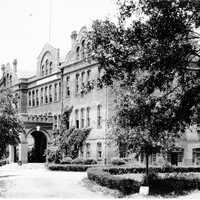-
Creator
-
Tuskegee University
-
Description
-
Since the 1890s, Tuskegee Institute’s Agricultural Campus held annual Farmer’s Conference on Campus to teach Black farmers the latest agriculture techniques. The Farmer’s Conference laid the groundwork to help establish the Cooperative Extension Program, which improved the lives of farmers in the rural American South. To expand the agricultural department, Tuskegee purchasing more land located west of the campus to create a new agricultural facility. The Milbank Agricultural Building was completed in 1909 with a gift of $20,000 donated by Elizabeth Milbank Anderson. The building was named in honor of Jeremiah Milbank, the owner of Borden Milk Company and Elizabeth’s father.
William Sidney Pittman, Booker T. Washington’s son-in-law, designed Milbank into a three and half story brick building. With Robert R. Taylor supervising its construction, Milbank housed new classrooms, laboratories, and an assembly room.
Milbank housed George Washington Carver’s personal laboratory and played a critical role in expanding agricultural research. Students developed techniques in producing dairy products in its creamery laboratory. Also, students provided care for domesticated animals and raised poultry such as chicken, geese, and ducks. They also studied cholera using blood serum from hogs to understand the transmission of viruses and attempted to look for vaccines. Since 1917, a new diary and horse barn were constructed near Milbank, adding to an expanding Agricultural Campus.
Today, Milbank Hall is currently empty, but the building still stands. Initial renovations were completed in 1985. It is undergoing another renovation while agricultural students attend classes in James H. Henderson Hall.
-
Title
-
Milbank Building
-
Date
-
C. 1900s
-
Subject
-
Institutional History
-
Source
-
TU
-
Coverage
-
TU
-
Format
-
JPEG
-
Publisher
-
Tuskegee University
-
Rights
-
All rights held by the archives. For permission to publish, distribute, or use this image for any other purpose, please contact the archives, Tuskegee University.
 Milbank Hall
Milbank Hall